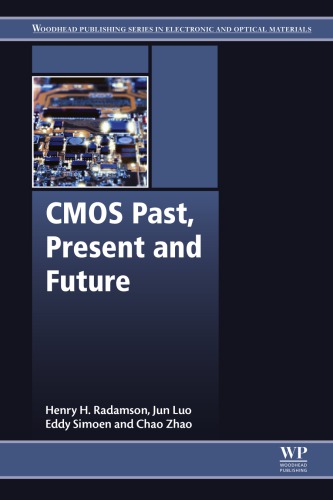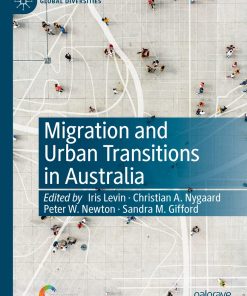CMOS Past, Present and Future. Luo 9780081021408 0081021402
$50.00 Original price was: $50.00.$25.00Current price is: $25.00.
CMOS Past, Present and Future. Luo. – Ebook Instant Download/Delivery ISBN(s): 9780081021408,0081021402
Product details:
- ISBN 10: 0081021402
- ISBN 13: 9780081021408
- Author: Henry Radamson; Eddy Simoen; Jun Luo; Chao Zhao
CMOS Past, Present and Future provides insight from the basics, to the state-of-the-art of CMOS processing and electrical characterization, including the integration of Group IV semiconductors-based photonics. The book goes into the pitfalls and opportunities associated with the use of hetero-epitaxy on silicon with strain engineering and the integration of photonics and high-mobility channels on a silicon platform. It begins with the basic definitions and equations, but extends to present technologies and challenges, creating a roadmap on the origins of the technology and its evolution to the present, along with a vision for future trends. The book examines the challenges and opportunities that materials beyond silicon provide, including a close look at high-k materials and metal gate, strain engineering, channel material and mobility, and contacts. The book’s key approach is on characterizations, device processing and electrical measurements.
Table contents:
Part 1: Basics of metal–oxide–semiconductor field-effect transistor (MOSFET)
1.1 Introduction
1.2 Basics of MOSFET’s operation
1.3 Figures of merit of MOSFETs
1.4 Evolution of the MOSFET structure
Part 2: Scaling and evolution of device architecture
2.1 Introduction
2.2 Dimension and architectural scaling
2.3 Lithography for downscaling
2.4 Electron-beam lithography (EBL)
2.5 Strain engineering
2.6 Impact of scaling
2.7 Beyond CMOS and beyond Si CMOS
Part 3: Strain engineering
3.1 Introduction
3.2 Basic definitions of strain type and design
3.3 Strain design in MOSFETs
3.4 Methods to induce strain in the CMOS structure
3.5 Embedded Si1 − yCy(eSi1 − yCy) for nMOS
Part 4: High-κ dielectric and metal gate
4.1 The scaling of MOSFET devices
4.2 SiO2 and poly-Si gate electrode
4.3 High-κ dielectric and metal gate
4.4 Hafnium-based high-κ dielectrics
4.5 Integration of HfO2 dielectric with compatible metal gate electrodes
4.6 High-κ dielectric and metal gate electrodes for FinFETs
4.7 Summary
Part 5: Channel materials
5.1 Introduction
5.2 High-mobility channels
5.3 SiGe channel
5.4 Ge channel
5.5 GeSn channel
5.6 III-V channel
5.7 Two-dimensional channel materials
Part 6: Challenges in ultra-shallow junction technology
6.1 Introduction
6.2 Basics of dopant activation and diffusion
6.3 Shallow boron junctions in silicon
6.4 N-type diffusion in germanium
6.5 Summary and outlook
Part 7: Advanced contact technology
7.1 Introduction
7.2 Characterizations of extremely low ρc
7.3 Ohmic contacts on Si/SiGe substrate
7.4 Ohmic contacts on Ge/III-V
7.5 Ohmic contacts on potential CMOS channel materials
7.6 Summary
Part 8: Advanced interconnect technology and reliability
8.1 Introduction
8.2 Copper interconnect integration
8.3 Low-k dielectric characteristics and classification
8.4 Copper interaction with silicon and dielectrics
8.5 Metal diffusion barriers
8.6 Reliability of copper metallization
8.7 Reliability of advanced intermetal dielectrics
8.8 Reliability statistics and failure models
8.9 The future of interconnect: beyond Cu and low-k
8.10 Summary
People also search:
metal silicides in cmos technology past present and future trends
cmos physics
cmos process
the past present and future quotes
history of cmos
You may also like…
Politics & Philosophy
Power-Sharing in Europe: Past Practice, Present Cases, and Future Directions 1st Edition
Politics & Philosophy - Sociology
Technique - Transportation: Rail
Politics & Philosophy
The Human Rights Covenants At 50: Their Past, Present, and Future 1st Edition
Business & Economics - Industries
Politics & Philosophy - Warfare & Defence
NATO’s Burden-Sharing Disputes: Past, Present and Future Prospects
Technique - Transport
Politics & Philosophy - International Relations
Polarity in International Relations: Past, Present, Future 1st Edition Nina Græger
History - World History












